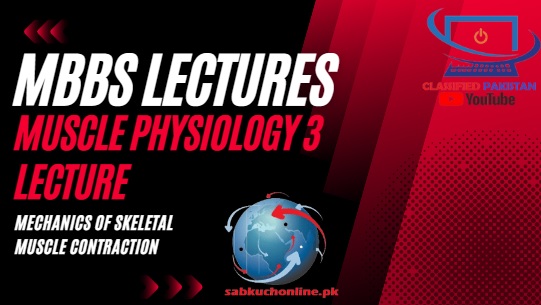Muscle Physiology 3 Slideshow
Learning Objectives:
At the end of the lecture the students should be able to:
• Explain the different energy systems of the skeletal muscle contraction
• Explain the concept of isometric and isotonic contractions
• Describe the features of types of muscle fibers
• Describe mechanics of skeletal muscle contraction
• Explain the remodeling of muscle to match function
Review of previous lecture
•Functions and features of actin and myosin and other proteins in skeletal muscle
•Steps of skeletal muscle contraction
•Sliding filament theory
•Walk along theory
•Rigor mortis

Energetics of Muscle Contraction
•When a muscle contracts against a load, it performs work
•To work we require energy
•Where does that energy come from?
Sources of energy for muscle contraction?
Sources of energy for muscle contraction
•We require energy for
•Walking of myosin heads on actin during contraction
•Pumping of calcium back into sarcoplasmic reticulum
•Pumping of sodium and potassium
•ATP is adequate for contraction for 1-2 seconds
•ATP is dephosphorylated and produces energy
•ADP has to be re-phosphorylated to be used again
•Phosphocreatine—5-8 seconds
•Glycolysis –1 minute and is rapid
•Oxidative metabolism–longer periods
Characteristics of whole muscle contractions


Force-Length Relationship

•Isometric
•Vs
•Isotonic contractions

There are two types of muscle contraction.
1.Isotonic

ii. Isometric


Types of Muscle Fibers
•Slow Red fibers
•Fast White fibers
Type of Fibers
Slow, Type I, Red Muscles
•Smaller diameter
•Innervated by smaller nerve fibers.
•More extensive blood vessel system and more capillaries to supply extra amounts of oxygen.
•Greatly increased numbers of mitochondria to support high levels of oxidative metabolism.
•Large amounts of myoglobin, an iron-containing protein similar to hemoglobin in red blood cells.
•The myoglobin gives the slow muscle a reddish appearance and hence the name red muscle.
•Resistant to fatigue
•Extensors and flexors
•Glycogen low
Fast, Type II, White Muscles
•Larger diameter
•An extensive sarcoplasmic reticulum is present for rapid release of calcium ions to initiate contraction.
•Large amounts of glycolytic enzymes are present for rapid release of energy by the glycolytic process.
•Less extensive blood supply .
•Fewer mitochondria than do slow fibers, also because oxidative metabolism is secondary.
•A deficit of red myoglobin in fast muscle gives it the name white muscle.
Fatiguable
Ocular muscles
Glycogen high

Mechanics of Skeletal Muscle Contraction
Muscle Twitch
•Muscle contraction in response to a stimulus that causes action potential in one or more muscle fibers
•Phases
•Lag or latent
•Contraction
•Relaxation

Summation
•The adding together of the individual twitch contractions to increase the intensity of overall muscle contraction
•Multiple Fiber summation
•Frequency summation
Multiple Motor Unit Summation

Multiple Fiber Summation

•As the strength of signal increases, larger and larger motor units begin to contract
•Size Principle
The size principle
•motor units are recruited in order of their size.
•Small motor units have small motor neurons and they are recruited first.
•Large motor units have large motor neurons and they are recruited last.
Multiple-Wave Summation or Frequency Summation

•As frequency of action potentials increase, frequency of contraction increases
•Action potentials come close enough together so that the muscle does not have time to completely relax between contractions.
Incomplete tetanization

•Stimulation of muscle fiber by increasing frequency, that every next stimulus acts during the preceding one i.e. relaxation period
•Every contraction starts before the end of previous one
•Partial relaxation between the subsequent contractions
•Calcium ions increase the strength of contraction
Complete tetanization

Tetanization

COMPLETE TETANIZATION
•Stimulation of muscle fiber by increasing frequency, that every next stimulus acts during the preceding one i.e. contraction period
•Every contraction merges with the previous one
•No relaxation between the contractions
•Smooth sustained contraction
•Early fatigue
Treppeor Staircase effect

•Graded response
•Occurs in muscle rested for prolonged period
•Each subsequent contraction is stronger than previous until all equal after few stimuli
Muscle Remodeling
•Atrophy
•Hypertrophy
•Hyperplasia
•Adjustment of Muscle length


Summary of Mechanics
1Muscles pull. The sarcomere shorten
2Muscle force can be graded by recruitment of motor units
3Small motor units are activated first: the size principle
4Muscle force can be increased by repetitive stimulation
5 Muscle velocity is inversely related to muscle force
6Muscles fatigue: they drop force on continued use
7Muscle are in certain amount of tautness even at rest
8Muscle remodels to match the functions
Skeletal Muscle Action Potential

